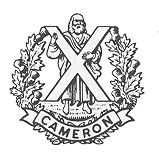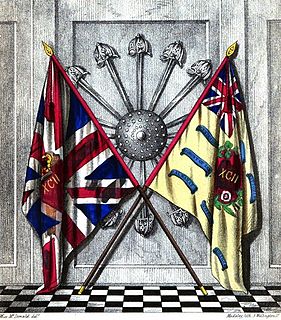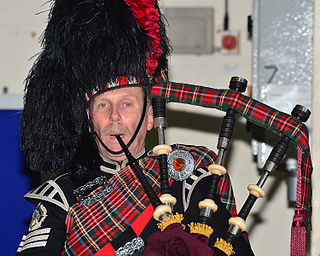
The 2nd Infantry Division was a Regular Army infantry division of the British Army, with a long history. Its existence as a permanently embodied formation dated from 1809, when it was established by Lieutenant General Sir Arthur Wellesley, as part of the Anglo-Portuguese Army, for service in the Peninsular War..

The Atholl Highlanders is a Scottish ceremonial infantry regiment. They are the only remaining private army in Europe, and act as the personal bodyguard to the Duke of Atholl; Chieftain of the Clan Murray, a family that has thrived in Perthshire for some 750 years. Although it has no official military role, this hand-picked body of local men are armed with Lee Metford rifles, and the regiment includes a pipe band. Joining the Highlanders is by invitation-only from the Duke, who specially selects men with ties to the estate or the local area. The regiment is not part of the British Army but under the command of the Duke of Atholl, and based in at Blair Castle, Blair Atholl.

James Munro VC was a Scottish recipient of the Victoria Cross, the highest and most prestigious award for gallantry in the face of the enemy that can be awarded to British and Commonwealth forces.

William George Drummond Stewart VC was a Scottish recipient of the Victoria Cross, the highest and most prestigious award for gallantry in the face of the enemy that can be awarded to British and Commonwealth forces.

The Gordon Highlanders was a line infantry regiment of the British Army that existed for 113 years, from 1881 until 1994, when it was amalgamated with the Queen's Own Highlanders to form the Highlanders. Although the 'gordon highlanders' had existed as the 92nd Regiment of Foot since 1794, the actual 'Gordon Highlanders Regiment' was formed in 1881 by amalgmation of the 75th (Stirlingshire) Regiment of Foot and 92nd Regiment of Foot.
The Highland Brigade is a historical unit of the British Army, which has been formed and reformed a number of times. It recruited men from the Highlands of Scotland.

The Seaforth Highlanders was a historic line infantry regiment of the British Army, mainly associated with large areas of the northern Highlands of Scotland. The regiment existed from 1881 to 1961, and saw service in World War I and World War II, along with many smaller conflicts. In 1961 the regiment was amalgamated with the Queen's Own Cameron Highlanders to form the Queen's Own Highlanders, which merged, in 1994, with the Gordon Highlanders to form the Highlanders. This, however, later joined the Royal Scots Borderers, the Black Watch, the Royal Highland Fusiliers and the Argyll and Sutherland Highlanders to create the present Royal Regiment of Scotland.

The Queen's Own Cameron Highlanders or 79th Regiment of Foot was a line infantry regiment of the British Army, raised in 1793. It amalgamated with the Seaforth Highlanders to form the Queen's Own Highlanders in 1961.

The 73rd Regiment of Foot was an infantry regiment of the British Army, raised in 1780. Under the Childers Reforms it amalgamated with the 42nd Regiment of Foot to form the Black Watch in 1881.

The 42nd Regiment of Foot was a Scottish infantry regiment in the British Army also known as the Black Watch. Originally titled Crawford's Highlanders or the Highland Regiment and numbered 43rd in the line, in 1748, on the disbanding of Oglethorpe's Regiment of Foot, they were renumbered 42nd and in 1751 formally titled the 42nd (Highland) Regiment of Foot. The 42nd Regiment was one of the first three Highland Regiments to fight in North America. In 1881 the regiment was named The Royal Highland Regiment , being officially redesignated The Black Watch in 1931. In 2006 the Black Watch became part of the Royal Regiment of Scotland.

The 92nd Regiment of Foot was a British Army infantry regiment, raised in 1794. Under the Childers Reforms it amalgamated with the 75th (Stirlingshire) Regiment of Foot to form the Gordon Highlanders in 1881.

The 72nd Highlanders was a British Army Highland Infantry Regiment of the Line, raised in 1778. Under the Childers Reforms it amalgamated with the 78th (Highlanders) Regiment to form the 1st Battalion of the Seaforth Highlanders in 1881.

The 78th (Highlanders) Regiment of Foot was a Highland Infantry Regiment of the Line, raised in 1793. Under the Childers Reforms it amalgamated with 72nd Regiment, Duke of Albany's Own Highlanders to form the Seaforth Highlanders in 1881.

The 71st Regiment of Foot was a Highland regiment in the British Army, raised in 1777. Under the Childers Reforms it amalgamated with the 74th (Highland) Regiment of Foot to become the 1st Battalion, Highland Light Infantry in 1881.
The 91st Regiment of Foot was a Line Regiment of the British Army, raised in 1794. Under the Childers Reforms it amalgamated with the 93rd Regiment of Foot to form the Argyll and Sutherland Highlanders in 1881.
The 93rd Regiment of Foot was a Line Infantry Regiment of the British Army, raised in 1799. Under the Childers Reforms, it amalgamated with the 91st Regiment of Foot to form the Argyll and Sutherland Highlanders.
Loudon's Highlanders, or the 64th Highlanders, or Earl of Loudon's Regiment of Foot, was an infantry regiment of the British Army.

The feather bonnet is a type of military headdress used mainly by the Scottish Highland infantry regiments of the British Army from about 1763 until the outbreak of World War I. It is now mostly worn by pipers and drummers in various bands throughout the world. It is also worn in a similar fashion by regiments in various Commonwealth armies.
The 75th (Stirlingshire) Regiment of Foot, was a British Army line infantry regiment, raised in 1787. Under the Childers Reforms it amalgamated with the 92nd Regiment of Foot to form the Gordon Highlanders in 1881.
The 74th Regiment of (Highland) Foot or 74th Regiment of Foot was a British Army line infantry regiment from 1777 to 1784 which was raised to fight in the American Revolutionary War.












